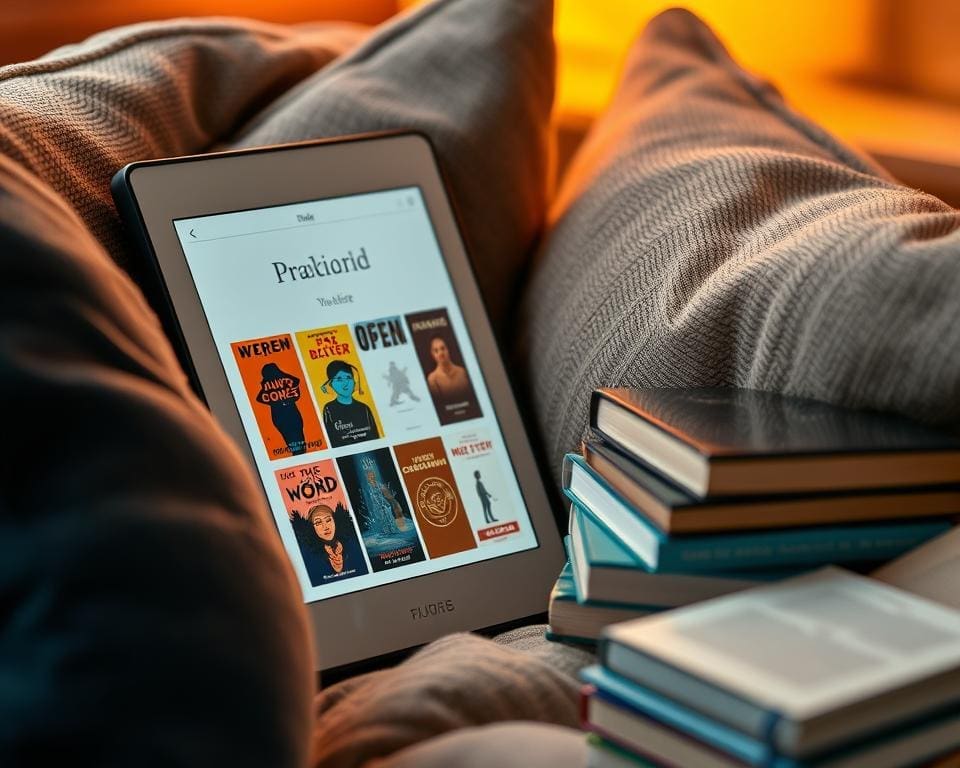The emergence of E-Readers has revolutionised the way we engage with literature, seamlessly blending technology with the cherished tradition of reading. These digital reading devices allow users to carry thousands of e-books in a lightweight format, making reading not only accessible but also remarkably convenient anytime and anywhere. Popular models like Amazon’s Kindle and Kobo have advanced to offer features that cater to diverse lighting conditions while boasting impressive battery life.
As we delve into this topic, it becomes evident that E-Readers present a modern solution to the common hurdles associated with traditional book ownership. Their affordability and portability are enticing benefits, especially as platforms like Waterstones broaden the horizons of e-books, drawing in a new demographic eager to experience the joy of reading through digital means.
The Rise of E-Readers in Modern Reading Culture
The emergence of e-readers has transformed the landscape of modern reading culture. These innovative devices have gained immense traction, appealing to a diverse range of readers seeking the convenience of accessing digital books. With the proliferation of the internet and widespread smartphone use, electronic readers have become a staple in many households.
Platforms such as Apple’s iBooks and Google’s Play Books have enabled effortless engagement with vast libraries of digital books. Readers no longer need to visit physical bookstores, allowing them to explore literature at their own pace. The seamless integration of technology into reading experiences has fostered a new appreciation for literature, appealing to both avid readers and casual enthusiasts.
Statistics reveal a significant increase in e-reader sales, particularly during the unique circumstances posed by recent global events. As people adapted to limitations in physical access to bookstores, many turned to electronic readers, illustrating a profound shift in reading habits. This cultural evolution reflects a broader societal trend, with individuals increasingly gravitating towards the flexibility and accessibility afforded by e-readers.

Benefits of Using Portable E-Readers
Portable e-readers revolutionise the way we consume literature, offering unparalleled advantages in today’s fast-paced world. The ease of carrying a library’s worth of books in a slim device reflects the convenience that appeals to readers, whether commuting to work or at leisure. Their ability to provide access to a vast array of titles instantly makes them a preferred choice among avid readers.
Convenience and Accessibility of Digital Reading Devices
Digital reading devices enhance the reading experience through their practical features. With adjustable font sizes and built-in lighting, these devices cater to diverse reading needs, including those of individuals with visual impairments. The lightweight and portable nature of e-readers means they fit seamlessly into any lifestyle. As an example, the Amazon Kindle Paperwhite remains a popular model, known for its user-friendly design and broad accessibility options. This accessibility encourages more individuals to embrace reading, further widening the community of book lovers.
Cost-Effectiveness: Affordable E-Readers for Every Budget
The cost-effectiveness of e-readers plays a significant role in their increasing popularity. These portable e-readers come in a variety of price ranges, catering to both moderate budgets and those seeking premium features. Brands such as Kindle and Kobo present competitive pricing, often resulting in e-books costing considerably less than their print counterparts. Platforms like Project Gutenberg enhance this value by offering numerous free e-books, allowing readers to broaden their collections without significant investment. This affordability encourages a more extensive exploration of literature and redefines the concept of book ownership.
E-Readers: Making Books Portable and Affordable
The quintessential allure of e-readers lies in their capacity for making books portable and affordable. By embracing digital technology, avid readers can now enjoy the freedom of carrying entire libraries in their bags, or even pockets, thanks to devices designed for efficiency. Pocket-sized readers, like the Kobo Clara HD, exemplify this remarkable ease of use, transforming the reading experience into something entirely liberating.
Affordability remains a critical factor, with e-readers offering high-quality features without breaking the bank. Users benefit from enhanced reading experiences through user-friendly interfaces, built-in dictionaries, and comprehensive note-taking capabilities. This innovative technology meets the evolving needs of modern readers, making reading accessible to a broader audience searching for ways to engage with literature.
As a result, e-readers not only accommodate various reading preferences but also foster a culture of inclusivity in literature. Their portability is central to their appeal, allowing individuals the flexibility to experience books in ways previously unimaginable.
Comparing E-Readers and Traditional Books
In the contemporary age, where convenience often dictates our reading preferences, the choice between e-readers and traditional books becomes increasingly vital. Each format presents unique benefits, yet the advantages related to space saving significantly tilt the balance in favour of e-readers.
Space Saving: Fitting Your Library in a Pocket
E-readers epitomise innovation in the realm of reading, particularly concerning space management. Traditional books can accumulate quickly, demanding ample storage and hefty bags to transport them. In contrast, pocket-sized readers allow countless titles to reside in a single device. This functionality is especially advantageous for avid readers who value accessibility and efficiency.
Devices like the Amazon Kindle Paperwhite underscore the benefits of adopting e-readers. They facilitate easy organisation of digital libraries and enable readers to enjoy a substantial collection without the associated clutter of physical books. Users can quickly switch between genres, authors, and interests at the touch of a button, adding to the appeal of comparing e-readers and traditional books.
Space saving features transform the reading experience, allowing for effortless transitions whether at home, commuting, or travelling. The compact nature of e-readers empowers readers to carry their entire library, showcasing a modern solution to a timeless hobby.
The Evolution of E-Books and Digital Books
The journey of e-books marks a profound shift in literature consumption and production, transforming how readers engage with texts. From the early days of simple text files to the sophisticated formats available today, the evolution of e-books illustrates remarkable advancements.
Initially, e-books appeared in rudimentary formats such as plain text and PDF, limiting their accessibility and interactivity. The advent of the ePub format revolutionised digital books, providing a more flexible framework that accommodates different devices and screen sizes. This change laid the groundwork for diverse publishing options, allowing authors to explore new avenues for creativity.
As technology progressed, the integration of multimedia elements in digital books enriched the reading experience. Authors began incorporating videos, hyperlinks, and images, transforming static reading into an interactive journey. This evolution enhances engagement, allowing readers to delve deeper into the content.
Subscription services, exemplified by platforms like Scribd, have emerged, offering vast libraries of e-books for a nominal fee. This shift encourages a culture of reading, enabling access to a wide range of literature without the constraints of traditional purchasing methods.
The evolution of e-books continues to unfold, reflecting society’s changing habits and preferences. As digital books grow in popularity, the landscape of literature will likely keep evolving, providing readers with unprecedented access to knowledge and stories.
Popular E-Reader Models and Their Features
In the vast landscape of digital reading, several popular e-reader models stand out, each designed to enhance the reading experience through innovative features. Leading the pack is the Amazon Kindle range, particularly the Kindle Paperwhite, known for its exceptional high-resolution display that delivers crisp text even in bright sunlight. Its waterproof capabilities add an extra layer of convenience, allowing book lovers to enjoy their stories by the pool or in the bath without concern.
Equally impressive is the Kobo family, which captivates many with features such as OverDrive integration. This functionality enables users to borrow e-books directly from libraries, making it easier than ever to access a plethora of titles without the need to purchase them. For those who appreciate a varied reading experience, models like the Nook and PocketBook offer distinct designs and user-friendly interfaces that cater to diverse preferences.
Whether you opt for the robust capabilities of the Kindle or the library-access benefits of Kobo, each of these popular e-reader models provides unique features that accommodate various reading habits. As technology continues to evolve, these devices not only allow readers to carry entire libraries in their pockets but also enhance the joy of reading, making literature more accessible than ever before.









